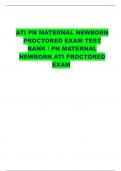Exam (elaborations)
Davis Advantage for Understanding Medical-Surgical Nursing 7th Edition STUDY GUIDE By Williams & Hopper ISBN: 9781719644594, All 57 Chapters Covered, Verified Latest Edition
- Course
- Institution
- Book
Davis Advantage for Understanding Medical-Surgical Nursing, 7th Edition STUDY GUIDE By Linda S. Hopper, Paula D.; Williams, Verified Chapters 1 - 57, Complete Newest Version Davis Advantage for Understanding Medical-Surgical Nursing 7th Edition STUDY GUIDE By Williams & Hopper ISBN: 9781719644594,...
[Show more]




